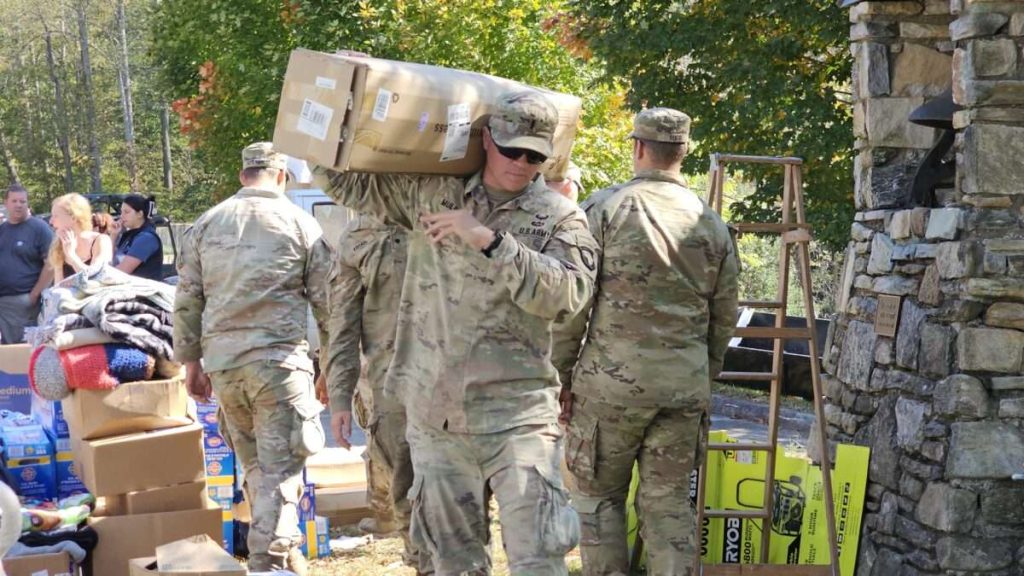It was a bone-chilling report. As North Carolinians reeled from the aftermath of Hurricane Helene, the Federal Emergency Management Agency (FEMA) suddenly ordered emergency workers “to stand down and evacuate” Rutherford County due to reports of “trucks of armed militias saying they were out hunting FEMA,” The Washington Post reported on October 13, based on an email obtained from the U.S. Forest Service.
The threat turned out to be something less serious. On October 14, the Rutherford County Sheriff’s Office announced the arrest of one man, William Jacob Parsons, for making a “comment about possibly harming FEMA employees” while armed with an assault rifle. Law enforcement concluded that “Parsons acted alone and there was no truck loads of militia,” according to a statement quoted in The Washington Post.
Parsons told the BBC that he was not a member of any militia, he had not threatened any federal officials, and he was there to help distribute supplies to hurricane victims.
Every time America suffers a natural disaster, it seems, there’s serious anxiety about social collapse and mass violence. And the media often runs with the most fantastical version, as journalists did with reports of violence at the Superdome refugee center in the aftermath of Hurricane Katrina in 2005.
These rumors by themselves can do serious damage. Louisiana National Guard Maj. Ed Bush told Reason in 2005 that “perhaps FEMA would have been quicker in if we hadn’t heard all these urban myths about shootings and rapes and deaths and killing and bodies everywhere.” Last week, relief efforts in Rutherford County and nearby Ashe County were paused due to the alleged militia threat.
Through a Freedom of Information Act (FOIA) request, Reason has obtained the original email thread about the threat. Forest Service firefighting official Gordy Sachs, quoting a message from FEMA, did indeed write to other officials on October 12 that “Title 10 troops had come across x2 trucks of armed militia saying they were out hunting FEMA.” (Both federal troops and National Guards under federal command are referred to as being under “Title 10 orders.”)
The Forest Service scrambled to figure out what was really happening. “Are you aware of this? Are we engaged? Any updates to share?” Tracy Perry, the service’s director of law enforcement and investigations wrote in an email to subordinates. “This is the first I’ve heard of this, I spoke with some LE [law enforcement] staff around 11:30 this morning and they did not mention anything,” an official, whose name and title were redacted, wrote back.
By that afternoon, officials had figured out the real story. An interim patrol commander at the Forest Service, whose name was redacted, replied to the email thread at 6.52 p.m. with a screenshot of a bulletin asking police to be on the lookout for a man who “made threats to FEMA and anyone that got in his way” and a photo of someone who appears to be Parsons.
“This has a great likelihood of [being] the earlier threat (unconfirmed),” the patrol commander wrote. The commander followed up 20 minutes later to write that “the suspect is in custody.”
Only the original email talking about “trucks of armed militia” was leaked to the press. The Washington Post reported on the alleged threat on the afternoon of October 13, apparently unaware that a suspect had been identified. “Two federal officials confirmed the authenticity of the email, though it was unclear whether the quoted threat was seen as credible,” the Post reported.
After Parsons’ arrest was publicized, the Post updated its story to focus on his alleged threat, and removed the phrase “armed militia” from the headline. As it turns out, U.S. soldiers had called in the threat—after hearing about it secondhand from a gas station cashier. “This was a lone individual,” Rutherford County Sheriffs Office Capt. James Keever told the Post. “We’re trying to get the word out about that.”
But other news outlets had already start to run with the story. “Trump’s Hurricane Lies Spark Terrifying Threat,” The New Republic stated, blaming former president Donald Trump’s criticism of FEMA for the alleged militia menace. In its own coverage of the militia threat, The Guardian reported that the “politicization” of the hurricane relief effort “has provided a recruitment opportunity for white supremacist groups who have assembled in devastated regions.” The Daily Beast featured a photo of an actual militia atop its coverage.
Rep. Chuck Edwards (R–N.C.) told NBC News that two counties in North Carolina were reporting “different militias attacking and threatening FEMA.”
On the ground, the picture looked quite different. People mostly stepped up to help each other and their communities. Volunteer aid organizations distributed supplies across North Carolina and the surrounding states. Reason did witness a militia-like operation near Asheville—but rather than attacking relief workers, the “redneck air force” was cooperating with authorities to run helicopter flights to isolated towns.
And rather than a terrifying plague of misinformation, at least one local official sees anti-FEMA conspiracy theories as mostly an annoyance.
“As far as I know, social media rumors did not impair response. They do tend to be a distraction, but my concern was that folks might quit helping if they thought their efforts were being undermined. That didn’t happen,” Glenn Jacobs, the mayor of Knox County, Tennessee, told Reason. Jacobs says recovery efforts following Hurricane Helene “once again showed how local communities come together to help their neighbors even before government is mobilized. I saw a lot of that.”
The post The Panic Over an Imaginary Militia ‘Hunting FEMA’ Did More Damage Than the Actual Threat appeared first on Reason.com.







